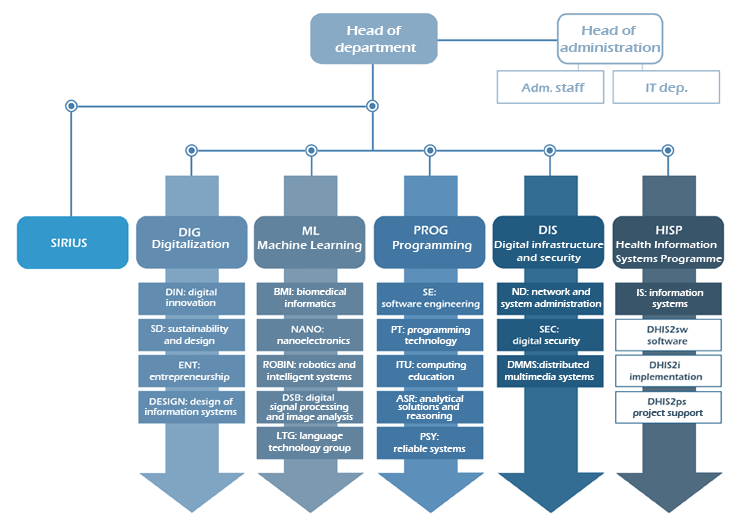There have been two key discussions, to prioritize research areas and and to adjust the organisational structure to the growth and increasing complexity of the Department. The resulting section structure highlights our strategic focus areas. At the same time emphasis has been on comprehensible section names:
- Digitalisation
- Machine Learning
- Programming
- Digital Infrastructure and Security
- Health Information Systems Programme (HISP)
Management 2.0
The new management team will be involved in crucial processes, strategic work and complex decisions. The management team consists of Head of Department, Deputy Head of Department, Education Director, Head of Office and the five new section managers. The structure will facilitate efficient management and also provide a broader perspective for the management team to be able to facilitate operations and continuous development of the Department in a comprehensive way.
The sectioning
Each section consists of one or more research groups that constitute the professional-social environment for our employees.

Digitalisation
The section aims at producing and disseminating new knowledge on digital innovation, digital design, digital entrepreneurship, as well as the role of design in the sustainability of digital artefacts. The research emphasizes on the socio-technical complexity of digitalisation and the individual, organisational and societal consequences of such processes.
Machine Learning
This sub-discipline of Computer Science powers dramatic progress in, among other things, Data Science and Artificial Intelligence in recent years. In a nutshell, machine learning enables computers to detect statistical regularities in potentially very large volumes of observed data, to derive generalisations and make predictions for previously unseen inputs.
Programming
Software lies at the core of all IT-systems. The Programming Section performs research and teaching on how to develop high quality software that benefits society and that is useful for both individuals and organisations.
Digital infrastructure and security
The overarching research themes are computer communications and computer security. Within communications everything from transmission of packets (both on wired and wireless links) to high level programs that facilitate viable and secure communication between applications are covered. Within security the research spans a wide area of themes within information security and cyber security.
Health Information Systems Programme (HISP)
HISP is a global action research project considered as one of the University of Oslo's greatest international successes. HISP has developed the DHIS2 software – an IT system for collecting, validating, analyzing and presenting data for health information management activities. The system has revolutionized collection and use of health data in developing countries. DHIS2 was originally tailored for the health sector, but is also useful within other areas, such as water, sanitation and hygiene, logistics, education and agriculture.